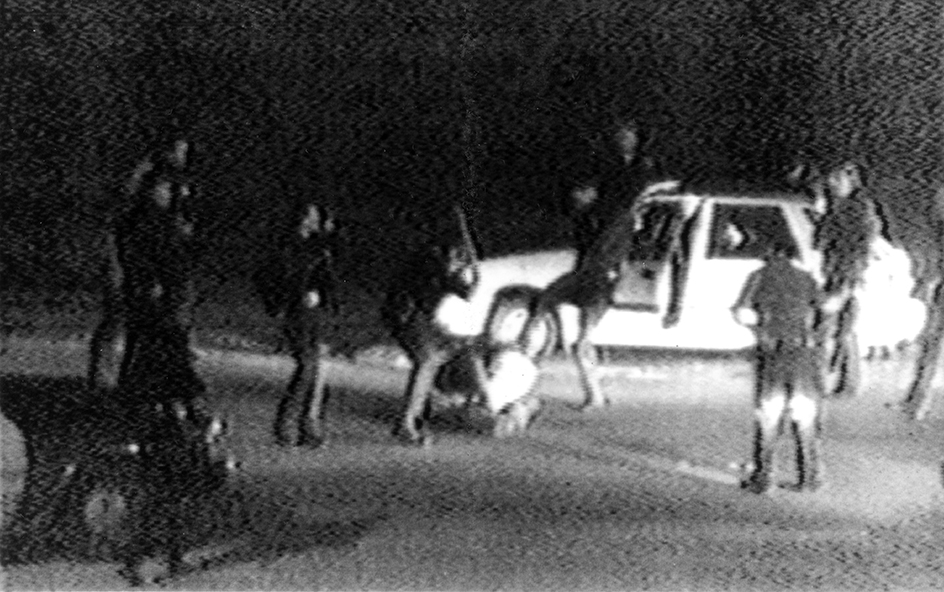Rodney King incident involved the controversial police beating of an African American motorist in Los Angeles. It took place in the early morning hours of March 3, 1991. Police had attempted to stop Rodney King while he was driving on a freeway. King resisted, and a high-speed chase followed. After King was stopped and removed from the car, officers kicked him and beat him with batons. An onlooker recorded video footage of the beating, and the footage was shown on television. The incident quickly gained national attention.
The police officers faced criminal charges in the incident, but a jury with no African Americans acquitted them of all but one charge. The verdict sparked widespread outrage and claims of racial injustice. The incident was a chief cause of highly destructive riots in Los Angeles in the spring of 1992.
The incident.
On the night of March 2, 1991, King had been drinking with friends. King had two passengers in his car when he was driving on the 210 Freeway early on March 3. California Highway Patrol officers noticed King driving erratically. They attempted to pull him over, but he drove away at high speed. The officers followed King off the freeway and into residential neighborhoods. The officers, now joined by members of the Los Angeles Police Department (LAPD), caught up with King. They ordered him to exit his vehicle and lie on the ground.
King had been paroled (conditionally released from prison) after serving time for a 1989 robbery conviction. He later said that he fled the officers because he feared being sent back to prison for a parole violation. King struggled with the LAPD officers as they tried to subdue him. Sergeant Stacey Koon shot King with a Taser—a weapon that stuns a target with an electrical current. King then lunged at one of the officers. Koon and officers Laurence Powell, Theodore Briseno, and Timothy Wind kicked King and beat him with batons. King was badly injured.

The video.
George Holliday, who lived near the scene of the incident, captured footage of the beating on his video camera. During an 81-second segment of the 9 minute video, the officers are shown shocking King, kicking him, and beating him with batons. Holliday gave the video to KTLA, a local television station. The station replayed the footage a number of times. By March 5, the story had become national news.
Charges and trial.
The officers involved in the Rodney King beating faced several criminal charges, including assault. The trial was held in Simi Valley, a mainly white suburb of Los Angeles. On April 29, 1992, the jury acquitted (found not guilty) the officers of all but one charge. The remaining charge was later dropped. No African Americans had served on the jury.
In December 1992, Los Angeles Police Chief Willie Williams asked prosecutors to consider filing charges against King for evading arrest and driving while intoxicated. But prosecutors dropped the charges, stating that prosecuting King would unnecessarily reopen “a deep wound in society.”
Riots.
Soon after news media reported on the officers’ acquittals, protesters began gathering at LAPD headquarters and in parts of South-Central Los Angeles (now called South Los Angeles). The protests quickly turned violent. A number of rioters looted stores, assaulted bystanders, and set fires. The riots lasted from April 29 to May 2. The violence killed 53 people, injured more than 4,000, and caused about $1 billion in property damage.
Federal charges.
On April 17, 1993, a federal jury found Sergeant Koon and patrolman Powell guilty of violating King’s civil rights. Officers Briseno and Wind were acquitted. On August 4, a federal judge sentenced Koon and Powell to 2 1⁄2 years in prison. In 1994, another federal jury ordered the city of Los Angeles to pay King about $3 3/4 million in damages.
In the years after the incident, Los Angeles adopted a number of reforms to its police department. Reforms included civilian reviews of police misconduct cases. The videotaped images of Rodney King’s beating made him a symbol of police brutality and of strained relations between minorities and police. King died on June 17, 2012.
See also Los Angeles (History) ; Los Angeles riots of 1992 .
